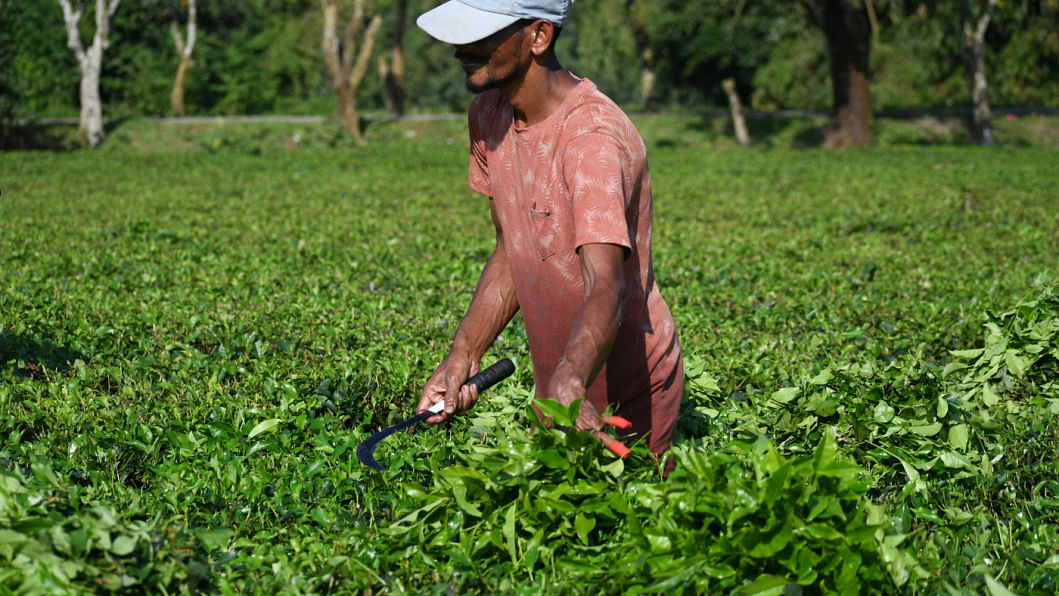Northern tea farming shrivelled by unfair prices

Just three decades ago, Panchagarh was a poverty-stricken district in north Bangladesh. Sugarcane, paddy, and some seasonal vegetables were the main crops grown there. During the off seasons, many people spent days without work. According to the Bangladesh Bureau of Statistics (BBS), the poverty rate in the Rangpur division was 47.2 percent in 2016.
Though the poverty rate has not decreased much in other districts of Rangpur, it has decreased significantly in Panchagarh. One of the reasons for that is the fast-growing tea industry there.
Currently, more than 100,000 men and women are regularly employed at stone quarries and tea plantations with a daily wage of Tk 400-700. Between 2000 and 2021, about 11,433 acres of plain land was brought under tea farming in five northern districts – out of 50,000 acres of suitable land. Tea board officials in Panchagarh said there was a shortage of about 25,000-30,000 workers for the fast-expanding tea farming in the region.
Initially, the tea industry appeared to be a boon for all, but irregularities and mismanagement seem to have turned that into a curse. One of the main concerns is that tea farmers have not been getting fair prices for years. If the problems are not fixed promptly, the industry will have to face long-term troubles.

According to the tea board, producing tea leaves on plain land costs around Tk 8-10 per kg. At present, farmers can sell tea leaves for only Tk 14-16 per kg. When they take their produce to tea processing factories, 20-40 percent of the leaves get discarded for various reasons – wet leaves, low quality, etc. So, if a farmer sells 100 kg (or, one quintal) of tea leaves at the rate of Tk 15 per kg, instead of getting Tk 1,500, they would actually get Tk 1,200 at best, which is the price of 80 kg of leaves.
They have to pay tea workers Tk 300 (Tk 3 per kg) for picking each quintal of tea leaves. Added to that is the transportation cost of Tk 100 per quintal. So a farmer is actually suffering a loss of Tk 200 per quintal.
Tea board officials say that if tea leaves are wet during the monsoon season, tea factories can discard 10 percent of the total harvest at maximum. But in reality, factory owners are rejecting more than 20 percent, which is unethical. Tea board officials claimed that factories are regularly raided and fined to stop excessive deductions.
On the contrary, tea growers complain that not only during the monsoon season, but factory owners discard 20-40 percent of the tea leaves brought to them throughout the year, and the tea board and local administration play a silent role in this regard. Protests don't make any difference.
Although the district administration fixed the price of tea leaves at Tk 18 per kg this year, tea factories are not buying tea at that price. Farmers also complained that the factory owners formed a syndicate and did not want to buy tea leaves during peak time. Thus, the factory owners are making a profit by driving farmers away from fair prices. To mitigate the losses, many tea growers have started planting mango trees in their tea gardens.
On the other hand, tea factory owners claimed that they would face losses if they did not discard "bad" tea leaves because growers harvest wet leaves all the time. Tea leaves are plucked using scythes instead of by hand, which is the reason behind bad quality leaves. Moreover, they claim that, due to the low price in auction markets, they are not able to pay good prices to tea farmers.
Visiting Panchagarh recently, I found that tea farmers were cultivating relatively fast-growing, low-quality Indian varieties instead of the 23 good-quality varieties developed by the Bangladesh Tea Board. Most marginal farmers in Panchagarh are growing new tea gardens on their croplands with no previous experience. As a result, they are dispensing fertiliser inappropriately, thus affecting soil fertility. The cost of tea production can be reduced further if fertilisers are applied after testing the soil, as advised by agriculture officials.

According to regional tea board officials, there are more than 7,000 small-scale tea farmers in Panchagarh, Thakurgaon, Lalmonirhat, Nilphamari and Dinajpur districts. Last year, the production of tea (finished goods) from the northern districts was more than 14.5 million kg, with a market value of approximately Tk 225 crore. The government earned a revenue of Tk 34 crore and the tea board also received about Tk 2 crore from the tea cultivated in this region.
In the northern region, tea plantation increased by about 12.4 percent and production increased by 41 percent in 2021 compared to 2020. Now, these plainland tea plantations are supplying 15 percent of total domestic production, second to only Sylhet.
While the government, tea board and factory owners have benefited, farmers have been suffering losses for years.
If farmers don't get a fair price for their produce, they can't make any profit after investing a lot of money year after year. They also need proper training and technical skills to be able to grow good-quality tea, for which the government is responsible. If they can't grow quality tea, exports won't grow, which in turn will affect local market prices.
If that happens, what can tea farmers do, except lose interest in growing tea?
The bottom line is, the tea board should train farmers, and the government should ensure fair prices by monitoring tea factory owners in Panchagarh. They can also set up state-run tea processing factories and auction centres in Panchagarh. This may save the tea industry of the plainlands.
Mostafa Shabuj is the Bogura correspondent of The Daily Star.

 For all latest news, follow The Daily Star's Google News channel.
For all latest news, follow The Daily Star's Google News channel. 




Comments